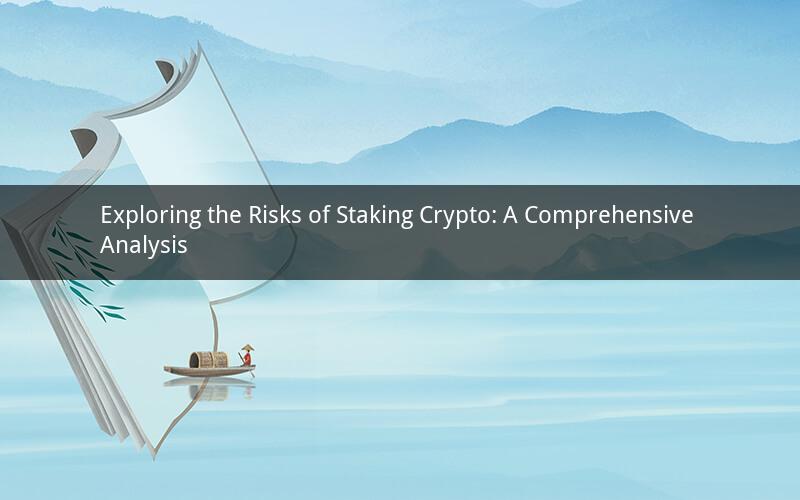
Introduction:
Staking crypto has gained immense popularity in recent years, offering users the opportunity to earn rewards for holding and locking their digital assets. However, as with any investment, there are inherent risks involved. In this article, we will delve into the various risks associated with staking crypto and provide a comprehensive analysis of the potential dangers involved.
1. Market Volatility:
One of the primary risks of staking crypto is market volatility. The value of cryptocurrencies can fluctuate drastically in a short period, leading to potential losses for stakers. When the price of a staked asset decreases, the amount of rewards earned may also diminish. Therefore, it is crucial for stakers to carefully monitor the market and understand the potential volatility associated with their chosen cryptocurrency.
2. Smart Contract Vulnerabilities:
Smart contracts are used to facilitate staking processes and ensure the security of the network. However, vulnerabilities in smart contracts can lead to significant risks. If a smart contract contains bugs or is exploited by malicious actors, staked assets may be compromised. It is essential for stakers to research and choose reputable platforms with robust smart contracts to minimize this risk.
3. Centralization Concerns:
While many staking platforms aim to decentralize the process, there are still concerns regarding centralization. Some platforms may require users to lock up a significant amount of their assets, which can lead to a concentration of power. Centralization can increase the risk of manipulation and reduce the overall security of the network. Stakers should carefully evaluate the decentralization aspect of a platform before participating in staking.
4. Regulatory Risks:
The regulatory landscape for cryptocurrencies is still evolving, and staking crypto is no exception. Governments around the world are grappling with how to regulate this emerging asset class, and changes in regulations can impact stakers significantly. Stakers should stay informed about the regulatory environment and be prepared for potential changes that may affect their staked assets.
5. Platform Risks:
The risk associated with the platform itself cannot be overlooked. There have been instances where staking platforms have suffered from security breaches, leading to the loss of staked assets. It is crucial for stakers to research and choose reputable platforms with a strong track record of security and reliability. Additionally, understanding the terms and conditions of the platform is essential to avoid unexpected risks.
6. Liquidity Risk:
Staking cryptocurrencies often involves locking up assets for an extended period, which can lead to liquidity risks. If stakers need to withdraw their assets before the end of the locking period, they may face penalties or be unable to access their funds. It is important to consider the liquidity requirements and potential penalties associated with the chosen staking platform.
7. Network Performance:
The performance of the underlying blockchain network can impact the staking process. Poor network performance, such as high transaction fees or slow confirmation times, can hinder the staking experience. Stakers should research the network's performance and consider its scalability and efficiency before participating in staking.
8. Technical Risks:
Technical issues, such as software bugs or hardware failures, can pose risks to stakers. These issues can disrupt the staking process, leading to potential losses. Stakers should ensure they have reliable software and hardware setups to minimize technical risks.
9. Market Manipulation:
The cryptocurrency market is prone to manipulation, and staking can be susceptible to such practices. Market manipulation can affect the price of staked assets, leading to potential losses for stakers. Stakers should stay informed about market trends and be cautious of any suspicious activities.
10. Exit Scams:
Exit scams are a significant risk in the cryptocurrency space. Some staking platforms may suddenly disappear, taking staked assets with them. Stakers should thoroughly research the credibility and reputation of the platform before participating in staking.
Frequently Asked Questions:
1. What is the difference between staking and mining?
Staking involves locking up and validating transactions on a blockchain network, while mining involves using computational power to solve complex mathematical puzzles to validate transactions and create new blocks.
2. Can I lose all my staked assets?
Yes, there is a possibility of losing all your staked assets if the platform experiences a security breach, or if the underlying cryptocurrency's value plummets significantly.
3. How can I reduce the risks associated with staking crypto?
To minimize risks, research and choose reputable platforms with robust security measures. Stay informed about market trends and regulatory changes, and diversify your staked assets across different cryptocurrencies.
4. Can I withdraw my staked assets at any time?
The ability to withdraw staked assets depends on the platform and the locking period. Some platforms may charge penalties or require a waiting period before allowing withdrawals.
5. Is staking a good investment for everyone?
Staking can be a good investment for those who understand the risks and have a long-term perspective. However, it is important to assess your own risk tolerance and financial goals before participating in staking.